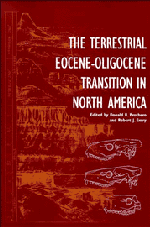Book contents
- Frontmatter
- Contents
- Contributors
- Preface
- PART I The Chronostratigraphy of the Uintan through Arikareean
- PART II Common Vertebrates of the White River Chronofauna
- 16 Testudines
- 17 Squamata
- 18 Ischyromyidae
- 19 Cylindrodontidae
- 20 Castoridae
- 21 Canidae
- 22 Nimravidae
- 23 Amphicyonidae
- 24 Small Arctoid and Feliform Camivorans
- 25 Merycoidodontinae and Miniochoerinae
- 26 Leptaucheniinae
- 27 Leptomerycidae
- 28 Camelidae
- 29 Hyracodontidae
- Summary
- Index
18 - Ischyromyidae
Published online by Cambridge University Press: 06 July 2010
- Frontmatter
- Contents
- Contributors
- Preface
- PART I The Chronostratigraphy of the Uintan through Arikareean
- PART II Common Vertebrates of the White River Chronofauna
- 16 Testudines
- 17 Squamata
- 18 Ischyromyidae
- 19 Cylindrodontidae
- 20 Castoridae
- 21 Canidae
- 22 Nimravidae
- 23 Amphicyonidae
- 24 Small Arctoid and Feliform Camivorans
- 25 Merycoidodontinae and Miniochoerinae
- 26 Leptaucheniinae
- 27 Leptomerycidae
- 28 Camelidae
- 29 Hyracodontidae
- Summary
- Index
Summary
ABSTRACT
Ischyromys is known from the early Duchesnean to the early Whitneyan of the Rocky Mountains and Great Plains of North America. Early species are morphologically diverse and are known from small and sometimes fragmentary samples, so the Duchesnean history of the group is hard to unravel. A diverse radiation of species with a derived but variable jaw musculature dominates the Chadronian of the Rocky Mountains. These species have been assigned to Ischyromys by some authors and Titanotheriomys by others. The name Titanotheriomys is recognized herein as a subgenus of Ischyromys. The Orellan of the Great Plains is dominated by two species of Ischyromys that lack the Titanotheriomys specializations. Both these species are also known from the Chadronian of the Great Plains based on a few fragmentary remains. Ischyromys became less abundant in the Rocky Mountains and more abundant in the Great Plains at the Chadronian/Orellan (Eocene/Oligocene) boundary, but no new species originated and no existing species underwent measurable change during the transition.
INTRODUCTION
Ischyromys is one of the most common rodents of the Eocene-Oligocene transition in North America, with a history of discovery going back to the early F. V. Hayden expeditions of the 1850s. Clark and Kietzke (1967), in their systematic paleoecological study of the South Dakota badlands, found Ischyromys to be the most common rodent in every environment and to be most abundant in dry plains environments lacking trees.
- Type
- Chapter
- Information
- The Terrestrial Eocene-Oligocene Transition in North America , pp. 373 - 398Publisher: Cambridge University PressPrint publication year: 1996
- 5
- Cited by

